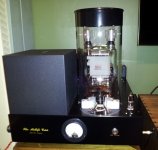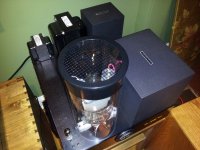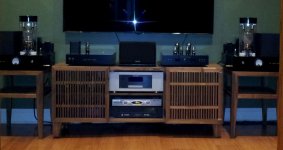Hi Magz, congratulations for such an achievement. I know how it fells as I went through a similar process when building the 814 A2 SE amplifier. In my case, instead of such monster monoblocks, I have 7 power supplies as it is DC coupled. I found the bass very powerful as am sure the 833 is.
How stable is the 833 anode current after time of running?
have you noticed any sound different after running them for a while?
cheers
Ale
How stable is the 833 anode current after time of running?
have you noticed any sound different after running them for a while?
cheers
Ale
All that's missing is a photo of you standing shirtless in front of the glowing amps holding whatever it is that you use to generate your audio signal. (Did I get that right George?)
Nah, there is a big difference between his great work of art and engineering and my clip lead Rube Goldberg machine!
I got a question from Magz back in Dec. 2012 about my 833A experiments. I have always stated that amps like this are rather hard to pull off and the success rate here on this forum for designs of this magnitude is virtually ZERO.
Often the builder spends a bunch of time and money to build something that usually doesn't work, or worse, blows up, or fries an OPT. The remains then show up on Ebay a year or two down the road and the builder leaves the hobby.
Yes, there have been a few high powered push pull designs done here, and I too have one in the works using sweep tubes. These require the same level of engineering and construction due to the power and voltage levels involved, but a high powered SE design with a medium Mu triode achieving HiFi frequency response is a step beyond reasonable. The OPT is a major challenge and where my design fell short. Here the builder went to a good supplier, and spent the money needed to get the job done right.
At first I did not believe that these things would work or even survive, but the builder has proven me WRONG this time.....WELL DONE!
I got a question from Magz back in Dec. 2012 about my 833A experiments. I have always stated that amps like this are rather hard to pull off and the success rate here on this forum for designs of this magnitude is virtually ZERO.
Often the builder spends a bunch of time and money to build something that usually doesn't work, or worse, blows up, or fries an OPT. The remains then show up on Ebay a year or two down the road and the builder leaves the hobby.
Yes, there have been a few high powered push pull designs done here, and I too have one in the works using sweep tubes. These require the same level of engineering and construction due to the power and voltage levels involved, but a high powered SE design with a medium Mu triode achieving HiFi frequency response is a step beyond reasonable. The OPT is a major challenge and where my design fell short. Here the builder went to a good supplier, and spent the money needed to get the job done right.
At first I did not believe that these things would work or even survive, but the builder has proven me WRONG this time.....WELL DONE!
...but a high powered SE design with a medium Mu triode achieving HiFi frequency response is a step beyond reasonable.
I completely agree. It takes a true engineer to make something unreasonable a reality. Simply amazing Magz. I am green with envy. Enjoy your prize.
Hi Magz, congratulations for such an achievement. I know how it fells as I went through a similar process when building the 814 A2 SE amplifier. In my case, instead of such monster monoblocks, I have 7 power supplies as it is DC coupled. I found the bass very powerful as am sure the 833 is.
How stable is the 833 anode current after time of running?
have you noticed any sound different after running them for a while?
cheers
Ale
Anode current is rock steady. I was listening for 3 hours last night and after warmup the needles were very steady at 160mA. Temps stabilize at ~57C on the side heat sink (for the shunt reg pass MOSFET and driver MOSFET). I started out at 140mA on the first day to be safe, then went up to 150mA for the second day and am now at 160mA, where it will stay.
Sound is excellent. I'm hearing details and 3-D staging that simply wasn't there before. There is a lot of delicacy to this tube that you wouldn't think by looking at it. The bass is very powerful and deep - I watched There will be Blood Saturday night with the amps as part of my HT system, and when the oil rig exploded it felt like an earthquake under my house.
Fan noise is still a little noticeable between songs, so I will play around with damping the inside of the box to eliminate resonances and reflections, and dialing down the voltage a bit from its present full 12V. I seem to have plenty of airflow for cooling, so I can probably spare some.
Nah, there is a big difference between his great work of art and engineering and my clip lead Rube Goldberg machine!
I got a question from Magz back in Dec. 2012 about my 833A experiments. I have always stated that amps like this are rather hard to pull off and the success rate here on this forum for designs of this magnitude is virtually ZERO.
Often the builder spends a bunch of time and money to build something that usually doesn't work, or worse, blows up, or fries an OPT. The remains then show up on Ebay a year or two down the road and the builder leaves the hobby.
Yes, there have been a few high powered push pull designs done here, and I too have one in the works using sweep tubes. These require the same level of engineering and construction due to the power and voltage levels involved, but a high powered SE design with a medium Mu triode achieving HiFi frequency response is a step beyond reasonable. The OPT is a major challenge and where my design fell short. Here the builder went to a good supplier, and spent the money needed to get the job done right.
At first I did not believe that these things would work or even survive, but the builder has proven me WRONG this time.....WELL DONE!
Coming from you, George, that is a HUGE compliment - thanks!
Magz, I have been reading about the mid-life crisis amplifier for almost a year and I must ask, "Now that this is done, what is next?"
Awesome looking, well planned, aesthetically well designed, and from your description -- clean and powerful sounding (except for fan noise -- have you tried Noctua fans?).
Patiently waiting for your follow up possibly known as, "Mid-Life Crisis 2 -- Flirting with Lower Voltages and Younger Tubes".
Awesome looking, well planned, aesthetically well designed, and from your description -- clean and powerful sounding (except for fan noise -- have you tried Noctua fans?).
Patiently waiting for your follow up possibly known as, "Mid-Life Crisis 2 -- Flirting with Lower Voltages and Younger Tubes".
Awesome looking, well planned, aesthetically well designed, and from your description -- clean and powerful sounding (except for fan noise -- have you tried Noctua fans?).
The amps use Noctua NF-R8 fans. The fans themselves are very quiet and pretty much inaudible, until the glass cylinder and bottom plate go on, then there are some resonances that are audible. I didn't hear them in my workshop because the background noise level down there is quite a bit higher, and I never listened to BOTH amps at the same time (twice the SPL). I slapped an adhesive Soundcoat Sheet on the bottom panel of each amp and that helped, so next I'll try lining the inside under the fan with some thick felt (next time I have an able-bodied helper available to lift them). I have a screened cap for the cylinder arriving today; I don't think that will do much for the sound but it will keep curious fingers away from the 2300V B+. The noise is not terrible and it's completely inaudible when music is playing, but if I can get it quieter so much the better.
Magz, I have been reading about the mid-life crisis amplifier for almost a year and I must ask, "Now that this is done, what is next?"
Patiently waiting for your follow up possibly known as, "Mid-Life Crisis 2 -- Flirting with Lower Voltages and Younger Tubes".
These tubes are pretty young...new production!
My wife would like me to spend some time on the above-ground floors of the house for a while, she's tired of being a "workshop widow", so I may take a brief break from construction. I'm thinking of shifting gears for the next project and maybe building something digital like a high resolution PC-based source...with tubes, of course!
Mags, Like everyone else has said, great job!!
I'm collecting parts for a PC audio source project. (Probably be my summer time project).
It'll have the PC built in (little atom processor, no fans, SSD so no spinning HDD).
Basically the computer, dac, and tube based preamp for the dac. Small touch screen. All in a nice portable package.
I'm collecting parts for a PC audio source project. (Probably be my summer time project).
It'll have the PC built in (little atom processor, no fans, SSD so no spinning HDD).
Basically the computer, dac, and tube based preamp for the dac. Small touch screen. All in a nice portable package.
Magz,
When you find the time, could you post a video on Youtube ?
I'm quite curious to see and hear them in action.
When you find the time, could you post a video on Youtube ?
I'm quite curious to see and hear them in action.
So, I received the covers for the 833 "chimneys" and they fit perfectly - see pics.
Actually, they are simply 6" diameter house eave vent covers that I had powder coated black, and they fit the 150mm glass cylinder like they were made for it!
Best news...the covers reduce the fan noise a LOT! The 1/4" mesh screen must breakup the airflow enough to greatly reduce the relatively high frequency "wind tunnel" noise I was hearing. The amps are now almost silent at the listening position.
I'll probably still glue some felt on the bottom cover opposite the fan the next time I go in there, but it's not urgent now.
Actually, they are simply 6" diameter house eave vent covers that I had powder coated black, and they fit the 150mm glass cylinder like they were made for it!
Best news...the covers reduce the fan noise a LOT! The 1/4" mesh screen must breakup the airflow enough to greatly reduce the relatively high frequency "wind tunnel" noise I was hearing. The amps are now almost silent at the listening position.
I'll probably still glue some felt on the bottom cover opposite the fan the next time I go in there, but it's not urgent now.
Attachments
Magz,
When you find the time, could you post a video on Youtube ?
I'm quite curious to see and hear them in action.
Yeah, I should be able to do something in the next few days, once I figure out how to do it...
I'm thinking of shifting gears for the next project and maybe building something digital like a high resolution PC-based source...with tubes, of course!
ENIAC? 😀
An externally hosted image should be here but it was not working when we last tested it.
She also mentioned something about spending our money on a new kitchen and furnace this year...
Why do you need a furnace? Can't you just turn on your amp for a while? Maybe you should consider placing the amps by the cold air intake and just run the furnace blower... 🙂
~Tom
Last edited:
LOL, workshop widow. I like that.
Same problem here, LOL.
Do you have air filters on the chassis of those amps? The high voltage will suck up dust like crazy. It will need to be cleaned once in a while if you don't.
They sure do look nice. I bet your really proud.
Nick
Same problem here, LOL.
Do you have air filters on the chassis of those amps? The high voltage will suck up dust like crazy. It will need to be cleaned once in a while if you don't.
They sure do look nice. I bet your really proud.
Nick
LOL, workshop widow. I like that.
Same problem here, LOL.
Do you have air filters on the chassis of those amps? The high voltage will suck up dust like crazy. It will need to be cleaned once in a while if you don't.
They sure do look nice. I bet your really proud.
Nick
Yes, there are two 3" diameter low restriction fan filters on the bottom plate, all the way at the back. I can reach them from the back of the unit, pop them out, and clean/replace the filters as needed with out having to lift the amps.
I'm happy with them, for sure.
...and clean/replace the filters as needed with out having to lift the amps.
at 180 pounds each, that's a nice feature to have.
- Home
- Amplifiers
- Tubes / Valves
- The Midlife Crisis - My 833C Amp Build


